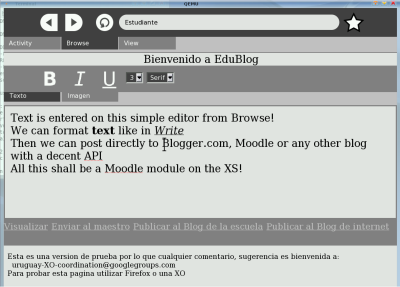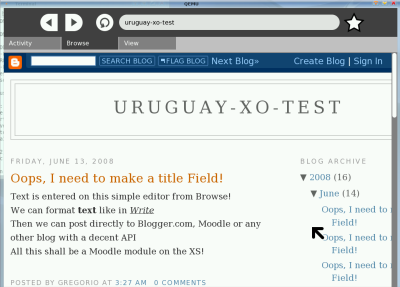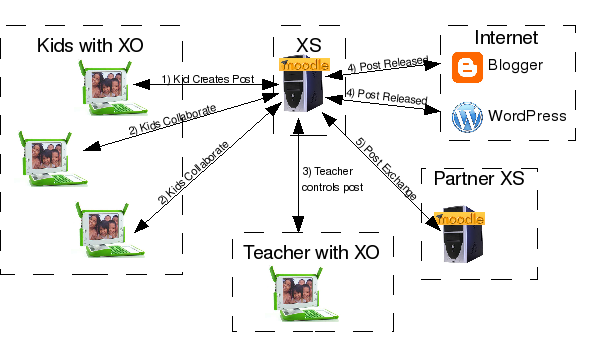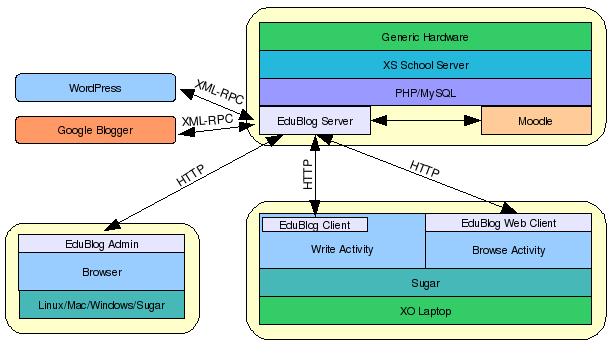Educational Blogger Project
Contents
Abstract
Blogs are an excellent educational tool as demonstrated by the use of Google Blogger in Villa Cardal, Uruguay. The kids had some issues and requested changes to make the system easier to use. Setting up the system on the XO was difficult due to Blogger's many features and bandwidth intensive resources. Technicians needed to assist in actually posting the blog entries to the internet. Very few (if any) current blogging systems are easy enough for use by young children in the low bandwidth environment they have in third world countries. The Educational Blogger Project will address these problems. Essentially, it stores posts locally using Moodle (or similar service) and allows for kids to collaborate, gives teachers the control they need and optimizes the process for the XO environment. It also allows teachers to release posts to Google Blogger, WordPress or other blogging system. The Educational Blogger Project significantly facilitates the use of blogs on the XO environment and makes it available for more widespread use. The ultimate goal is to create an system that can be set up easily on any XS and used by kids around the world.
Benefits of Educational Blogging System
- Allows teachers to use blogging as an effective educational tool by adding teamwork capabilities, creating a collaborative environment for students and simplifying the process
- Optimized for the XO and bandwidth, so users will have a great experience
- Gives OLPC a source of feedback and a way to see what is important to kids
- Makes kids happy! Kids requested blogging!
Problems with Current Blogging Systems
- The need for good connectivity
- Children getting confused with some options
- The number of steps involved in creating a post
- Difficulty in collaborating on a post
- Difficulty with monitoring and viewing posts before being published
Details
The design of this project addresses the concerns in the requirements specifications (Please note there will be mismatch since many areas were changed during discussion with my mentor, but not updated on the requirements page).
Use Case / Workflow
- 1) Kid Creates Post
- Children can use the Write Activity (AbiWord based) to create a post. A slight modification/plug-in to the Write activity would display a "post to blog" option for the child. When clicked, the post (taking advantage of Write's XHTML generation) and meta information (class its for, group, etc.) will be sent to the Educational Blogger Web Application on the XS. The XS will store the post locally using Moodle, WordPress or other similar web application (modified to incorporate needed user permissions, bandwidth optimized).
- 2) Kids Collaborate
- Children in the same group can collaborate on a post. To edit a post, a child can click on an edit link (which will appear if they have permission to edit that post) in the browser. The link will open Write and load the file for editing (file extension association). Uploading the edited post will be similar to creating a post, except that the user will not be prompted for extra information when saving.
- 3) Teacher Controls Post
- At all times, the teacher can view posts of all students in the class and edit/delete them. The teacher can also create users/groups, give students editing rights and perform other everyday administration tasks. The teacher also sets access rights for the post (internet, local, class only, group only).
- 4) Post Released
- The teacher also has the power to release the post (publish Generic WordPress server or other blogging site). This would essentially transfer all the post data using XML-RPC. The post will also be available for replication on partner servers.
- 5) Post Exchange
- A daemons system will replicate posts across partner servers. For example, a regional server could store all the posts in the region. Post Exchange serves to optimize a country's bandwidth as well as a school's bandwidth.
Major Components (Design Modified see Work Plan)
- EduBlog Client
- This is a modification/plug-in to the Write Activity and serves as the interface between Write and the EduBlog server. This consists of a slight GUI modification to Write so that a "Publish" option is shown in the menu. Clicking on that option will bring up a GUI allowing the child to select what class the post is for. Finally, the child can click "Submit" and send the data to the EduBlog Server using HTTP. All accessory files, such as images, will be sent to the server as well. XHTML generation is done by the Write Activity (already supported). Also, clicking on edit in the Browse Activity will open up Write and preload the page for editing and allow for easy updating through the EduBlog Client. The client is also partly responsible for authentication; initial implementation will store a password in the XO and submit that securely (md5) to the server with the post.
- EduBlog WebClient
- This is a browser based editor that can serve the same functionality as EduBlog Client. This can be a stripped down version of the WordPress client interface.
- EduBlog Server
- The EduBlog Server handles most of the communication between subsystems. When a post is or edited, the EduBlog server will alter Moodle (with blog plug-in) tables appropriately (either directly or through the Moodle API). It will also deal with concurrent editing issues by locking the post or merging changes. The EduBlog server also augments the Moodle database to support the specific user types needed and handles a post's view and edit permissions. It also allows teachers to make certain posts public by publishing them to blog sites on the internet. This will be done with plug-ins that allow it to interface with various blog systems such as Google Blogger and WordPress using XML-RPC (supported by both Blogger and WordPress as well as popular blog exchange API's such as GData, MetaWeblog and MovableType). In addition, EduBlog Servers running on different XS's will replicate posts as necessary through daemon processes to optimize local and national bandwidth.
- EduBlog Admin
- This is a web interface to administer the EduBlog Server (through PHP and XHTML forms). Teachers can use this interface to view and control the posts made by kids in their class, create/delete users, edit posts made by their class, create groups that can collaborate on a post and release posts to the internet. Admins can use this interface to configure the system such as settings for releasing to blog sites on the internet and what data is to be exchanged with partner servers.
Mock Ups
Student Page<br;>

After clicking post, the new post goes right to Blogger.com

Beta Server Hardware and Software Details
Tarun has a basic FTP host with Apache and PHP which we can use for mocking up the GUI. and doing some developing. Greg really wants to have a full blown School Server just like they have in schools in Uruguay.
We need 1 - a box and someone to image it with XS code. 2 - A primary sys admin and support for them 3 - An IP address, BW and a hosting location
Hardware Requirements:
The requirements are loosely based on XS_Server_Specification#XSX_Specifications :
Actual hardware implemented: EduBlog Beta Server Hardware
Software Requirements: Fedora 7-based standard XS software implementation Apache 2.0 PHP 5 PostgreSQL 8 Moodle FTP SSH
Actual software implemented: EduBlog Beta Server Software
Deliverables (Revised see Work Plan)
The major components described above are the deliverables for this project. The WebClient is not part of my proposal since the system can function with just the Write Activity modification. It may however streamline the blogging process for kids if implemented in the future. The EduBlog server will be capable of handling data sent from it if it is created.
The entire system will have to work on the XO environment (both client and server) and be optimized for bandwidth. In addition, at the end of the project, the system will be put into a one click install package for the XO server.
- EduBlog Client
- EduBlog Server
- EduBlog Admin
- One click installer for XS
Working plan
Latest plan here: http://wiki.laptop.org/go/Blog_Educativo_Plan_del_Proyecto
Older plan kept for the record here:
- Prior to GSoC Start: Configuring and familiarizing with the XO environment, Moodle, XML-RPC
- Week 1: Developing and testing EduBlog Client and sending data to EduBlog server
- Week 2: Incorporating user privileges into EduBlog Server
- Week 3: Developing and testing of storing of information in Moodle
- Week 4: Developing and testing plug-ins to publish to Blogger and WordPress
- Week 5: Developing and testing web application for administration
- Week 6: Package and test installer
- Week 7,8: Integration testing, further plug-ins depending on remaining time
- After GSoC End: Support, Upgrades, Maintenance
People Involved
Greg Smith (Gregorio) - Mentor
Tarun Pondicherry (tarun2000) - Intern, Developer, Anything Else I need to be
Marcel [Please enter your info =)]
Tony Pearson - Beta Server
If I missed you, add yourself!

